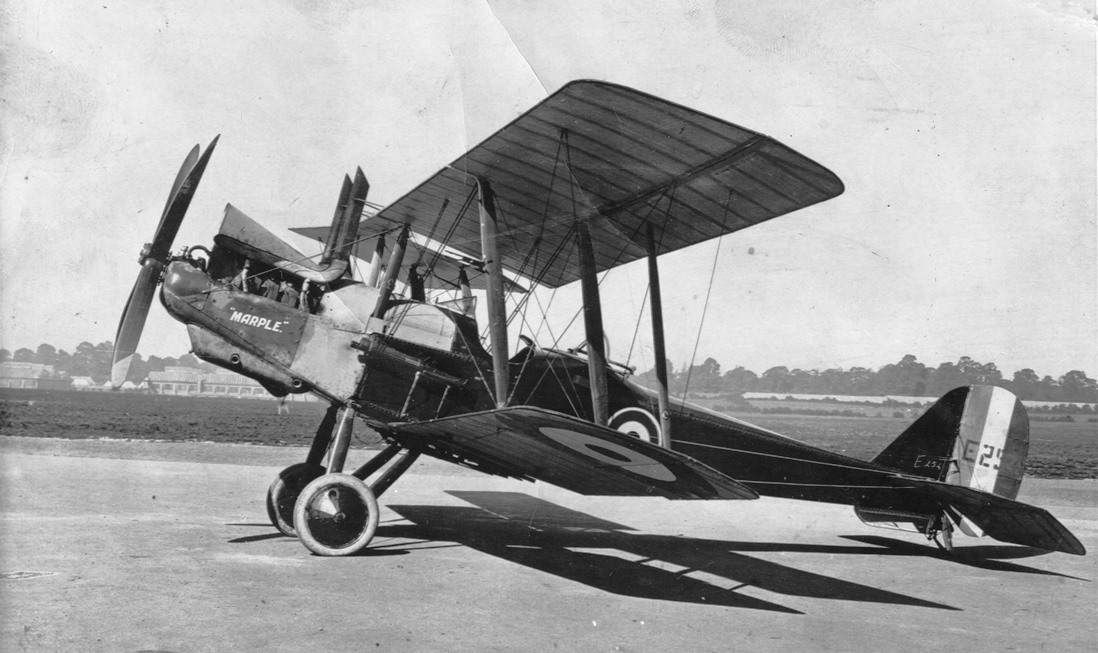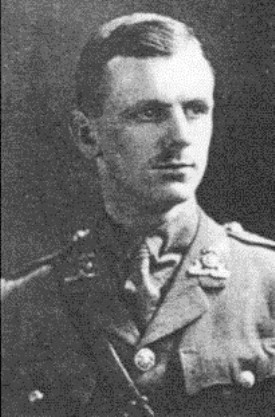Some times something really interesting turns up when you least expect it. I came across this photograph recently at Archives, and was intrigued to find out more. Stamped on the reverse are the words “Air Ministry”. Why is “Marple” painted on the engine cowling? Could it be linked to one of the Marple men who fought in the First World War?

 Bill Beard was able to identify the plane as a Royal Aircraft Factory R.E.8 built by Siddely Deasy at Coventry. Next, I checked the book “Remembered” by Peter Clarke, Andy Cook & John Bintliff (which records the Marple Men who died in the First World War) and found the entry for Lt Harold Carver Barlow. Harold (left) was the son of Frank Barlow JP and Mary Carver whose family had owned Hollins Mill. The Barlows were a prominent local family with interests in tea plantations, and they lived at Woodville on Buxton Lane, Marple. Lt Barlow, 20th Battalion Lancashire Fusiliers (4th Salford Pals) was attached to the 9th Squadron Royal Flying Corps and was killed in action in 1917, aged 26.
Bill Beard was able to identify the plane as a Royal Aircraft Factory R.E.8 built by Siddely Deasy at Coventry. Next, I checked the book “Remembered” by Peter Clarke, Andy Cook & John Bintliff (which records the Marple Men who died in the First World War) and found the entry for Lt Harold Carver Barlow. Harold (left) was the son of Frank Barlow JP and Mary Carver whose family had owned Hollins Mill. The Barlows were a prominent local family with interests in tea plantations, and they lived at Woodville on Buxton Lane, Marple. Lt Barlow, 20th Battalion Lancashire Fusiliers (4th Salford Pals) was attached to the 9th Squadron Royal Flying Corps and was killed in action in 1917, aged 26.
I contacted Dr Graham Winton, military historian, who confirmed that Harold Carver Barlow became the 53rd victim of the German Ace “The Red Baron” over Belgium in 1917. According to Graham:
“On the 18 June 1917, at 13.15pm. Manfred Albrecht Freiherr Von Richthofen (the Red Baron) with JG1, flying an Albatros D.V (789/17) shot down Lt Ralph Elly Ellis and Lt Harold Carver Barlow in an R.E.8 (A4290) of 9 Squadron at Hof Struywe, Square V.42. They were the 53rd of Richthofen's 80 victims.
The Red Baron, Manfred Albrecht Freiherr von Richthofen (2 May 1892 – 21 April 1918) was killed in action near Amiens on 21 April 1918.
No. 9 Squadron was formed and disbanded twice during the War. First formed on 8 December 1914 at St Omer in France from a detachment of the RFC HQ to develop the use of radio for reconnaissance missions; this lasted until March 1915. Re-formed at Brooklands on 1 April 1915 under the command of Major Hugh Dowding as a reconnaissance squadron, No. 9 returned to France in December 1915, flying Royal Aircraft Factory B.E.2s. It flew reconnaissance and artillery spotting missions during the Battle of the Somme in 1916. It re-equipped with R.E.8s in May 1917, using them for artillery spotting and contact patrols during the Battle of Passchendaele, during which it suffered 57 casualties. It was disbanded again in December 1919 and reformed as a bomber unit began on 1 April 1924 and remains in service.”
17th June 2017 will be the 100th anniversary of Lt Harold Carver Barlow’s death when he will be remembered on the Marple WW1 Timeline Tribute Display in the Marple Memorial Park.
Hilary Atkinson, January 2017
Postscript 2024
We believe we have now found the origin of the photograph of the R.E.8 at the head of this article. A book, ‘Aviation in Manchester’ by Brian Robinson describes a ceremony at the Manchester Athletic Club’s grounds in Fallowfield on 2nd March 1918. Two aircraft, funded by public subscription, were presented to representatives of the Indian forces. At that time the Indian army was independent of, but closely associated with, the British Army. They operated mainly in East Africa and the Middle East. One of the aircraft, an R.E.8, Serial E254, carried the name Marple, testifying to the savings efforts of the people of that town.
If we look closely at the photograph it has the name ‘Marple’ on the engine cowling, which is why we started investigating this in the first place. It also has a serial number on the tail plane - E2 followed by a partially obscured number and then by a completely obscured number. We cannot prove it beyond doubt but the partial number linked with the name ‘Marple’ shows it is almost certainly the airplane E254 that was paid for by the people of Marple and given to the war effort at the ceremony in Fallowfield. It will still retain its position at the head of this article as, even though it was made some months after Lt Barlow was killed, it is more closely linked to both him and to Marple than a generic picture of an R.E.8.
As an afterthought, the description in the book goes on to recount that after the ceremony, the Lord Mayor of Manchester flew over the city in a locally built aircraft, scattering leaflets exhorting the populace to greater efforts in support of war savings. He took off from Trafford Park and his circuit of the area was enlivened by forced landings at Heaton Chapel and Openshaw. Never a dull moment when you are Lord Mayor!

